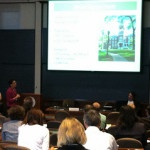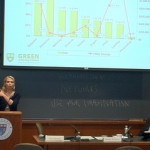We have much more to do and your continued support is needed now more than ever.
Green Revolving Loan Funds Come of Age on Campus
The Sustainable Endowments Institute (SEI) recently hosted a summit on financing the future of energy efficiency at Harvard University attended by approximately 150 higher education, business and non-profit leaders from all across the U.S. on May 15, 2012.
Green Campus Financing Advances
It was a watershed moment for campus and other sustainability enthusiasts because it illustrated just how far college and university leaders have come since financing tools were limited, when simple payback was the primary measure of the value of campus sustainability projects, and when savings from energy efficiency and conservation projects were generally lost to campuses’ or organizations’ general fund.
Addressing Disincentives to Conservation on Campus
Green revolving loan funds will help correct some of the unnecessary financial disincentives to conserve natural resources, it is expected, while adding a relatively new approach to the financial toolkit. So far, results are promising.
Last year, SEI released the report, Greening the Bottom Line, illustrating how 52 colleges and universities of all types and sizes all across the US are revolving savings from energy efficiency and other green campus efforts back into funds that finance additional conservation initiatives. Green revolving loan funds (GRFs) replenish through savings that are captured and reinvested in additional conservation programs.
Large Financial Returns for Going Green on Campus

SEI also found that students, administrators and facilities were about equally likely to serve as the initial promoters and champions of the existing GRFs and that both student fees (generated through referenda in which students vote generate a few dollars per term to campus sustainability activities) and administrative funding played leading roles in starting many of the funds.
“Billion Dollar Challenge” Spurs Progress
Mark Orlowski, founder and Executive Director of SEI, shared with summit attendees that “thirty-five higher education institutions have so far collectively pledged $83 million to their green revolving funds as part of the “Billion Dollar Green Challenge,” a new campaign SEI launched at the AASHE conference in October 2011.”
Among them is Agnes Scott College (my alma mater), which has committed to securing $1 million for its green fund. During her keynote presentation, Agnes Scott College President, Elizabeth Kiss, shared how support from SEI with implementation of a green revolving loan could help colleges advance sustainability objectives, particularly through help from consultation, case studies and tracking software.
GRITS Offers Assistance
SEI representatives demonstrated the new Green Revolving Investment Tracking System (GRITS), which is designed to help manage the many projects involved in green revolving fund, and will be made available to campus members of the “Billion Dollar Challenge.” Background on this campaign, case studies on successful green revolving funds at nine colleges and universities, an implementation guide and an investment primer are available on SEI’s website.

Additional Articles about Green Campus Financing Tools:
New Financing Tools Help Push for Green Campuses (review of Financing Sustainability on Campus by the National Association of College and University Business Officers, NACUBO)
Reflections on the Financing the Future of Energy Efficiency Summit by sustainability leader, Mitchell Thomashow
Harvard Leads Green Challenge with $12 Million, by Alyza J. Sebenius, quotes Harvard Sustainability Director, Heather Henriksen
(NWF’s Campus Ecology Program proudly joins more than one dozen organizations in co-sponsoring the Greening the Bottom Line report and in serving on the invitation committee for the Financing the Future of Energy Efficiency Summit. Our work is made possible through generous donations from NWF members, The Kendeda Fund, Bank of America Charitable Foundation, NASA and private donors. NWF’s Campus Ecology Program empowers student leaders to advance sustainability across the higher education curriculum, operations, and wider community.)





















